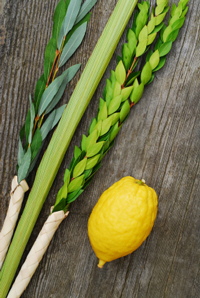


![]()
(Much of the following information is general knowledge, and other commentary came from the books God's Prophetic Calendar, by Lehman Strauss. Published by Loizeaux Brothers, Neptune NJ, ©Copyright 1987; and from The Gospel in the Feasts of Israel by Victor Buksbazen, Published by Friends of Israel Gospel Ministry, Bellmawr NJ, ©Copyright 2004. Used with permission. Feast overview charts are used with permission from Peter Wise of Internet Biblical Resources).
33And the LORD spake unto Moses, saying, 34Speak unto the children of Israel, saying, The fifteenth day of this seventh month shall be the feast of tabernacles for seven days unto the LORD. 35On the first day shall be an holy convocation: ye shall do no servile work therein. 36Seven days ye shall offer an offering made by fire unto the LORD: on the eighth day shall be an holy convocation unto you; and ye shall offer an offering made by fire unto the LORD: it is a solemn assembly; and ye shall do no servile work therein. 37These are the feasts of the LORD, which ye shall proclaim to be holy convocations, to offer an offering made by fire unto the LORD, a burnt offering, and a meat offering, a sacrifice, and drink offerings, every thing upon his day: 38Beside the Sabbaths of the LORD, and beside your gifts, and beside all your vows, and beside all your freewill offerings, which ye give unto the LORD. 39Also in the fifteenth day of the seventh month, when ye have gathered in the fruit of the land, ye shall keep a feast unto the LORD seven days: on the first day shall be a Sabbath, and on the eighth day shall be a Sabbath. 40And ye shall take you on the first day the boughs of goodly trees, branches of palm trees, and the boughs of thick trees, and willows of the brook; and ye shall rejoice before the LORD your God seven days. 41And ye shall keep it a feast unto the LORD seven days in the year. It shall be a statute for ever in your generations: ye shall celebrate it in the seventh month. 42Ye shall dwell in booths seven days; all that are Israelites born shall dwell in booths: 43That your generations may know that I made the children of Israel to dwell in booths, when I brought them out of the land of Egypt: I am the LORD your God. 44And Moses declared unto the children of Israel the feasts of the LORD (Leviticus 23:33-44).

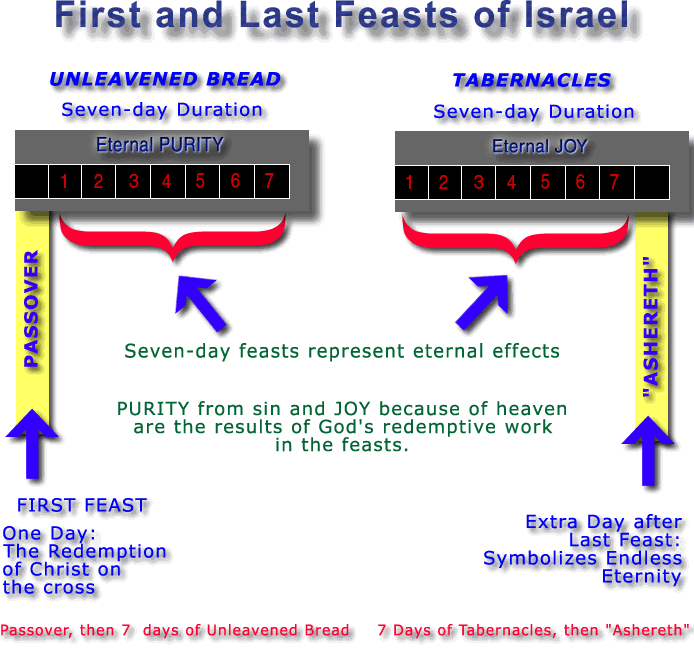
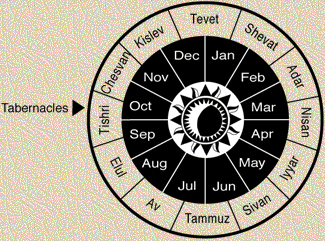 The Feast of Tabernacles
or Sukkoth, comes on the fifteenth day of Tishri, the seventh month on the
Jewish religious calendar, and it continues for seven days. The month, Tishri, coincides with the end of September or
early October. The feast is also called "Booths" because the people left their
dwellings to camp out in tent-like huts for seven days. "Ye shall dwell in
booths seven days; all that are Israelites born shall dwell in booths"
(Leviticus 23:42). This feast is one of the three in which God commanded the
Israelite men to assemble at Jerusalem and present their sacrifice and offerings
to the Lord: "They shall not appear before the LORD empty" (Deuteronomy
16:16). The feast is primarily agricultural in character and a joyous occasion.
It compares is some ways to our American Thanksgiving celebration. The harvest
has been gathered in and hearts are filled with praise for God's bounties. That
is why this feast is also called "The Feast of Ingathering," or "Israel's
Thanksgiving Festival" -- "the feast," as John 7:37 calls it.
The Feast of Tabernacles
or Sukkoth, comes on the fifteenth day of Tishri, the seventh month on the
Jewish religious calendar, and it continues for seven days. The month, Tishri, coincides with the end of September or
early October. The feast is also called "Booths" because the people left their
dwellings to camp out in tent-like huts for seven days. "Ye shall dwell in
booths seven days; all that are Israelites born shall dwell in booths"
(Leviticus 23:42). This feast is one of the three in which God commanded the
Israelite men to assemble at Jerusalem and present their sacrifice and offerings
to the Lord: "They shall not appear before the LORD empty" (Deuteronomy
16:16). The feast is primarily agricultural in character and a joyous occasion.
It compares is some ways to our American Thanksgiving celebration. The harvest
has been gathered in and hearts are filled with praise for God's bounties. That
is why this feast is also called "The Feast of Ingathering," or "Israel's
Thanksgiving Festival" -- "the feast," as John 7:37 calls it.
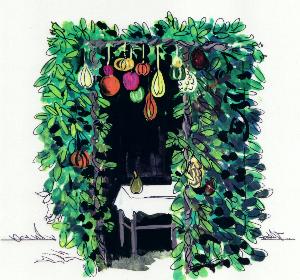
The Feast of Tabernacles also commemorates God's mighty deliverance of His people from Egypt and their forty years of wilderness wandering, when they dwelt in tents and tabernacles. For the last 3,500 years, Jewish people have been observing Sukkot by building little tabernacles or booths with walls of plaited branches and thatch for roofs, all of which give shade by day but permit the stars to gaze down by night upon the children of Israel as they faithfully fulfill the ancient command, "Ye shall dwell in booths seven days."
 In ancient times there was a
controversy between the Sadducees and the Pharisees concerning the booths. The
Sadducees held that the "boughs of goodly trees" pertained to the building of
the booths. The Pharisees, on the other hand, contended that the branches were
meant to be carried in the hands of the people celebrating. This they called the
lulav. A compromise was reached. The booths of branches satisfied the
Sadducees. In addition, the people used lulavs in their celebration. A
lulav is made of branches of palms, myrtles, and willows, all fastened with
a golden thread. These lulavs were then waved in the Temple during
certain parts of the service. Also, every Jewish person came to the Temple
holding an etrog, or citrus fruit, symbolic of the fruit of the
Promised Land. The booths, the lulav, and etrog are basic symbols
of the Feast of Tabernacles.
In ancient times there was a
controversy between the Sadducees and the Pharisees concerning the booths. The
Sadducees held that the "boughs of goodly trees" pertained to the building of
the booths. The Pharisees, on the other hand, contended that the branches were
meant to be carried in the hands of the people celebrating. This they called the
lulav. A compromise was reached. The booths of branches satisfied the
Sadducees. In addition, the people used lulavs in their celebration. A
lulav is made of branches of palms, myrtles, and willows, all fastened with
a golden thread. These lulavs were then waved in the Temple during
certain parts of the service. Also, every Jewish person came to the Temple
holding an etrog, or citrus fruit, symbolic of the fruit of the
Promised Land. The booths, the lulav, and etrog are basic symbols
of the Feast of Tabernacles.
Seventy bullocks for a sin offering were offered during the seven-day feast. The rabbis explain that this number of seventy bullocks was a sacrifice on behalf of the seventy nations of the world, looking toward their conversion to the God of Israel and their gathering under the Shekinah glory.
The Feast of Tabernacles, like the other feasts of Israel, focuses the attention of God's people on both the past and on the future. It was the seventh and final feast of the seventh month and lasted for seven days, completing the sacred cycle of the Lord's appointed times. This feast brought to completion God's clear purposes and plans in redemption for both the Church and Israel. Man's day will have run its course and God's redeemed ones will be gathered to Himself. Just as this feast marked the final gathering of "the fruit of the land" (Leviticus 23:39), so there will be a final gathering of all mankind, both the "wheat" and the "tares," which are the children of Christ's kingdom and the children of the wicked one. The prophetic message of the Feast of Tabernacles is that there is a shelter in the Tabernacle of God under the wings of the Shekinah glory, for the Jewish people first, and also for the Gentiles.
There were two outstanding features which characterized the Temple service of the Feast of Tabernacles:
The pouring of water in the Temple.
The brilliant illuminations of the Temple.
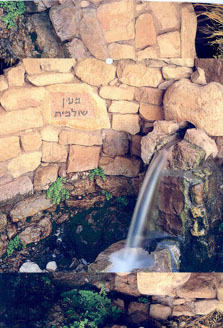 A specially appointed priest was
sent to the Pool of Siloam with a golden pitcher to bring water from the pool,
which was poured together with wine at the foot of the altar. The significance
of the pouring of the water was symbolic of prayer for abundant rain which
Israel needed for her daily bread. Even today in the synagogue much prayer for
rain is offered at this time. Secondly, the ritual of the pouring of the water
was also Messianic in its hope. It looked toward the outpouring of the Holy
Spirit, not only upon Israel, but also on the believers of the nations under the
reign of the Messiah King. The ritual of water pouring lasted six days,
climaxing on the seventh day, which concluded the Feast of Tabernacles. This seventh day was called
Hoshanah Rabbah, "The Day of the Great Hosanna." It has special Messianic
significance. The pouring of the water from the golden pitcher took place amidst
the blasting of the trumpets by the priests and singing of sacred music by the
Levites, while the people, waving their lulavs, chanted the Hallel Psalms
113-118. The closing words of Psalm 118 are these:
A specially appointed priest was
sent to the Pool of Siloam with a golden pitcher to bring water from the pool,
which was poured together with wine at the foot of the altar. The significance
of the pouring of the water was symbolic of prayer for abundant rain which
Israel needed for her daily bread. Even today in the synagogue much prayer for
rain is offered at this time. Secondly, the ritual of the pouring of the water
was also Messianic in its hope. It looked toward the outpouring of the Holy
Spirit, not only upon Israel, but also on the believers of the nations under the
reign of the Messiah King. The ritual of water pouring lasted six days,
climaxing on the seventh day, which concluded the Feast of Tabernacles. This seventh day was called
Hoshanah Rabbah, "The Day of the Great Hosanna." It has special Messianic
significance. The pouring of the water from the golden pitcher took place amidst
the blasting of the trumpets by the priests and singing of sacred music by the
Levites, while the people, waving their lulavs, chanted the Hallel Psalms
113-118. The closing words of Psalm 118 are these:
25 Save now, I beseech thee, O LORD: O LORD, I beseech thee, send now prosperity.
26 Blessed be he that cometh in the name of the LORD: we have blessed you out of the house of the LORD.
27 God is the LORD, which hath showed us light: bind the sacrifice with cords, even unto the horns of the altar.
28 Thou art my God, and I will praise thee: thou art my God, I will exalt thee.
29 O give thanks unto the LORD; for he is good: for his mercy endureth for ever.
From the words save now [Hebrew, Hoshanah], this day became known as the "Great Hosanna." It was a prayer for the speedy salvation through the Messiah. This is why our Savior was greeted at His Triumphal Entry into Jerusalem just prior to His crucifixion with the waving of palm branches and the words, "Hosanna to the Son of David," meaning, "Save us Son of David." They thought He was coming then to establish the Kingdom. It was while all this was going on, the pouring of the water into the altar basin, the blasting of the trumpets, the singing of the Psalms, when the Messianic fervor was at its highest pitch, that the Lord Jesus stood in the Temple crying out: "Now the Jews’ feast of tabernacles was at hand. In the last day, that great day of the feast ["The Great Hosanna"], Jesus stood and cried, saying, If any man thirst, let him come unto me, and drink. He that believeth on me, as the Scripture hath said, out of his belly shall flow rivers of living water" (John 7:2, 37-38). The Messianic claim of our Savior was clearly understood by all. Here Jesus was claiming to be the answer to the fervent hope and prayer of many generations. Could He, "the carpenter's son of Nazareth," be the long expected Messiah? So there was division among the Jews. Jesus is still the great divider of men today. Folks are either for Him or against Him. As that old song chorus reads: "What will you do with Jesus, Neutral you cannot be. One day your heart will be asking, What will He do with me?" A song written by Ron Hamilton puts it this way:
"What Will You Do with Jesus"
What will you do with Jesus, He Who redeemed your soul? What will you do with Jesus, He Who can make you whole? Sovereign of all the ages, Savior of Calvary, What will you do with Jesus? He longs to set you free.
What will you do with Jesus, He who became your sin? What will you do with Jesus, He who can cleanse within? Giver of life eternal, Victor of Hell's domain, What will you do with Jesus? Gladly He bore your pain.
What will you do with Jesus, Conquering Lord of all? What will you do with Jesus? Come while you hear His call! Follow His steps to Calvary, Humbly before Him bow. What will you do with Jesus? Call on His mercy now.
©Copyright 1982 by Majesty Music, Inc. All rights reserved. Used with permission.
On the last day of the feast, "Day of Great Hosanna," the Jewish people observe the custom of striking the branches of the willow three times. Upon the completion of a Messianic prayer for God to grant eternal salvation by Messiah, the willow branches are struck three times on the benches or chairs of the synagogue hoping that with each falling leaf a sin falls away from the one who prays. Most of them don't realize yet that only Yeshua [Jesus], the true Messiah, is able to bring forgiveness of sins.
Another central feature of the feat was the illuminations of the Temple in Jerusalem. The festive pilgrims came to the Temple bearing lights and torches while in the Temple itself the golden candlesticks were lighted, transforming the Temple area into one brilliant focus of light which illuminated most of Jerusalem. We read what our Lord says amidst all this splendor and brilliant lights of the Temple: Then spake Jesus again unto them, saying, I am the light of the world: he that followeth Me shall not walk in darkness, but shall have the light of life" (John 8:12).
So we can see that this feast is about (1) A harvest of thanksgiving; (2) A national commemoration of redemption; and (3) Faith's leap into the future, when Yahweh shall gather the nations in the Messianic Kingdom of His blessed Son, Jesus the Messiah. "And it shall come to pass, that every one that is left of all the nations which came against Jerusalem shall even go up from year to year to worship the King, and LORD of hosts, and to keep the feast of tabernacles. And it shall be, that whoso will not come up of all the families of the earth unto Jerusalem to worship the King, the LORD of hosts, even upon them shall be no rain" (Zechariah 14:16-17). Those who refuse to come to the feast to worship will be judged.
Presently, God lets His "sun rise on the evil and on the good, and sendeth rain on the just and the unjust" (Matthew 5:45). But the time is coming, when in the Millennial Kingdom, those who refuse to worship the King will get no rain. The apostle John, looking toward the greater Feast of Ingathering, wrote: "After this I beheld, and, lo, a great multitude, which no man could number, of all nations, and kindreds, and peoples, and tongues, stood before the throne, and before the Lamb, clothed with white robes, and palms in their hands, And cried with a loud voice saying, Salvation [Hosanna] to our God who sitteth upon the throne, and unto the Lamb" (Revelation 7:9-10).
God has written into His calendar a time when at the mention of the name of Jesus, "every knee shall bow and every tongue shall confess that Jesus Christ is Lord to the glory of God the Father" (see Philippians 2:9-11).
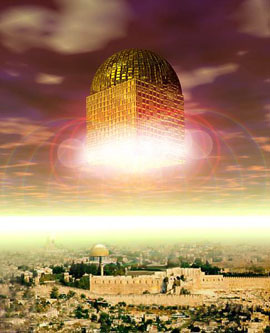
The Scriptures tell us of the day when man's rebellion against God will end, and the redeemed will enter Christ's glorious Kingdom. "And the ransomed of the LORD shall return, and come to Zion with songs and everlasting joy upon their heads: they shall obtain joy and gladness, and sorrow and sighing shall flee away" (Isaiah 35:10). We read these words in Revelation 21:1-3: "And I saw a new heaven and a new earth: for the first heaven and the first earth were passed away; and there was no more sea. And I John saw the holy city, new Jerusalem, coming down from God out of heaven, prepared as a bride adorned for her husband. And I heard a great voice out of heaven saying, Behold, the tabernacle of God is with men, and He will dwell with them, and they be His people, and God Himself shall be with them, and be their God."
When this last great Feast of Tabernacles is prophetically fulfilled, then holiness will shine forth at last, for "In that day shall there be upon the bells of the horses, HOLINESS UNTO THE LORD; and the pots in the LORD's house shall be like the bowls before the altar. Yea, every pot in Jerusalem and in Judah shall be holiness unto the LORD of hosts: and all they that sacrifice shall come and take of them, and seethe therein: and in that day there shall be no more the Canaanite in the house of the LORD of hosts" (Zechariah 14:20-21).
We close our study of this seventh feast with these words from the late Dr. Lehman Strauss: "The greatest fact of the past is that the Lord Jesus Christ appeared on this earth for a period of thirty-three years. In the wisdom and plan of God the Father, He appeared on planet earth, and this is precisely where He should have been at that time, for then 'He appeared to put away sin by the sacrifice of Himself' (Hebrews 9:26).
The greatest fact of the present is that the same Lord Jesus Christ appears in Heaven, highly exalted by God the Father. In the wisdom and plan of God, Heaven is precisely where He should be now. He entered 'into Heaven itself, now to appear in the presence of God for us' (Hebrews 9:24).
The greatest fact of the future is that this same Lord Jesus Christ will return to earth. When He comes, in the wisdom and plan of God, the earth is precisely where He should be. 'And unto them that look for Him shall He appear the second time without sin unto salvation' (Hebrews 9:28).
The King is coming! 'And the seventh angel sounded; and there were great voices in Heaven, saying, The kingdoms of this world are become the kingdoms of our Lord, and of His Christ: and He shall reign for ever and ever' (Revelation 11:15). What a Kingdom! What a King! How blessed will be that day when believing Israel and believing Gentiles bow before God's beloved Son!" (God's Prophetic Calendar, pp. 131-132).
"Unto Him that loved us, and washed us from our sins in His own blood. And hath made us kings and priests unto God and His Father, to Him be glory and dominion for ever and ever. Amen" (Revelation 1:5-6).
![]()